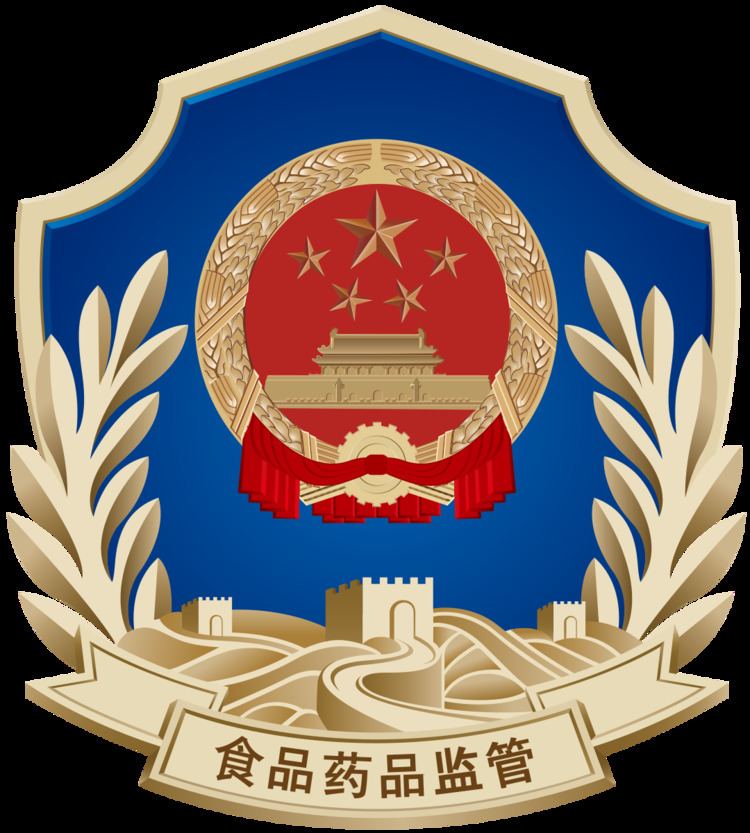Location Beijing, China | Director Bi Jingquan | |
 | ||
Formation 1950 (predecessor organization)
2013 (latest re-organization) Type Ministry-level regulatory body Headquarters 26-Yuan, Xuanwumen Avenue West, Xicheng District, Beijing Deputy Directors Yin Li, Wang Mingzhu, Teng Jiacai, Wu Zhen, Jiao Hong | ||
The China Food and Drug Administration (CFDA) (Chinese: 国家食品药品监督管理总局) was founded on the basis of the former State Food and Drug Administration (SFDA). In March 2013, the regulatory body was rebranded and restructured as the China Food and Drug Administration, elevating it to a ministerial-level agency. The headquarters is in Xicheng District, Beijing.
Contents
- Main responsibilities
- Registration for medical devices
- Organizational structure
- Principal officials
- Standards and regulations
- References
The CFDA replaced a large group of overlapping regulators with an entity similar to the Food and Drug Administration of the United States, streamlining regulation processes for food and drug safety. The China Food and Drug Administration is directly under the State Council of the People's Republic of China, which is in charge of comprehensive supervision on the safety management of food, health food and cosmetics and is the competent authority of drug regulation in mainland China.
On July 10, 2007, Zheng Xiaoyu, the former head of China's State Food And Drug Administration, was executed for taking bribes from various firms in exchange for state licenses related to product safety.
Main responsibilities
Draft laws, regulations and rules and policy plans on the administration and supervision of food (including food additives and health food, the same below) safety, drugs (including traditional Chinese medicines and ethno-medicines, the same below), medical devices and cosmetics; formulate normative documents, and facilitate the establishment and implementation of the food safety responsibility mechanism, under which food companies shall bear the main responsibility and local people's governments shall take integrated responsibility; establish the direct reporting system for critical food and drug information and supervise its implementation; take measures to reduce risks on regional and systemic food and drug safety;
Formulate the regulations on food administrative licensing and supervise their implementation; establish food safety risk management mechanism, formulate annual plans for nationwide inspection for food safety and programs for major control actions, and organize their implementation; establish the unified food safety information release system and release information on important food safety issues; participate in formulating food safety risk monitoring plans and food safety standards, and undertake food safety risk monitoring thereon;
Organize the formulation and publication of the national pharmacopeia, other drug and medical device standards and classification system, and supervise their implementation; develop good practices on research, production, distribution and use of drugs and medical devices, and supervise their implementation; undertake drug and medical device registration, supervision and inspection; establish monitoring system for adverse drug reactions, adverse events of medical devices, and undertake monitoring and response activities; draw up and improve regulations and qualifications for licensed pharmacists, guide and supervise the registration work; participate in formulating national essential medicine list and assist its implementation; formulate administrative provisions for cosmetics administration and supervise their implementation;
Formulate the investigation and enforcement system for food, drugs, medical devices and cosmetics, and organize their implementation; organize the investigation and punishment on major violations; establish recall and disposal system for defect products, and supervise the implementation;
Establish food and drug emergency response system, organize and guide the emergency response and investigation on food and drug safety incident, and supervise the implementation of investigation and punishment;
Formulate science and technology development plans for food and drug safety, and organize their implementation; accelerate the construction of food and drug testing system, electronic supervision tracking system, and information system;
Undertake the public communication, education and training, and international exchanges and cooperation in the field of food and drug safety; promote the establishment of credibility system;
Guide food and drug administration works of local governments, regulate administrative activities, and improve the interlocking mechanism between administrative enforcement and criminal justice;
Undertake the routine work of the Food Safety Commission of the State Council; take charge of comprehensive coordination on food safety administration, facilitate and improve the cooperation and coordination mechanism; supervise the work of provincial people's governments on food safety administration, and evaluate their performance;
Undertake other work assigned by the State Council and the Food Safety Commission of the State Council.
The State Food and Drug Administration is not responsible for regulating pharmaceutical ingredients manufactured and exported by chemical companies. This regulatory hole, which has resulted in considerable international news coverage unfavorable to China, has been known for a decade, but failure of Chinese regulatory agencies to cooperate has prevented effective regulation.
Registration for medical devices
The CFDA is responsible for registration of medical devices for the Chinese market. All medical devices have to be classified by the CFDA according to its risk in 3 classes. Depending on the risk classification, different aspects are required:
Organizational structure
Internal structure of CFDA
- General Office
- Dept. of Legal Affairs
- Dept. of Food Safety Supervision (I - III)
- Dept. of Drug and Cosmetics Registration (Dept. of TCMs and Ethno-Medicines Supervision)
- Dept. of Medical Device Registration
- Dept. of Drug Cosmetics Supervision
- Dept. of Medical Device Supervision
- Bureau of Investigation and Enforcement
- Dept. of Emergency Management
- Dept. of Science, Technology and Standards
- Dept. of Media and Publicity
- Dept. of Human Resources
- Dept. of Planning and Finance
- Dept. of International Cooperation (Office of Hong Kong, Macao and Taiwan Affairs)
Principal officials
Director: Mr. Bi Jingquan (since January 2015)
Other leaders:
Standards and regulations
The medical devices regulatory system is based on regulations issued by the State Council, CFDA orders and CFDA documents that provide detailed rules for medical device registration and licensing practice. Medical device type testing must be based upon the Chinese National Standard (Chinese: Guobiao, GB) or at least on an Industry Standard (YY). Thy system is undergoing frequent changes and adjustments. In October 2013, more than 104 new YY Standards have been released.
